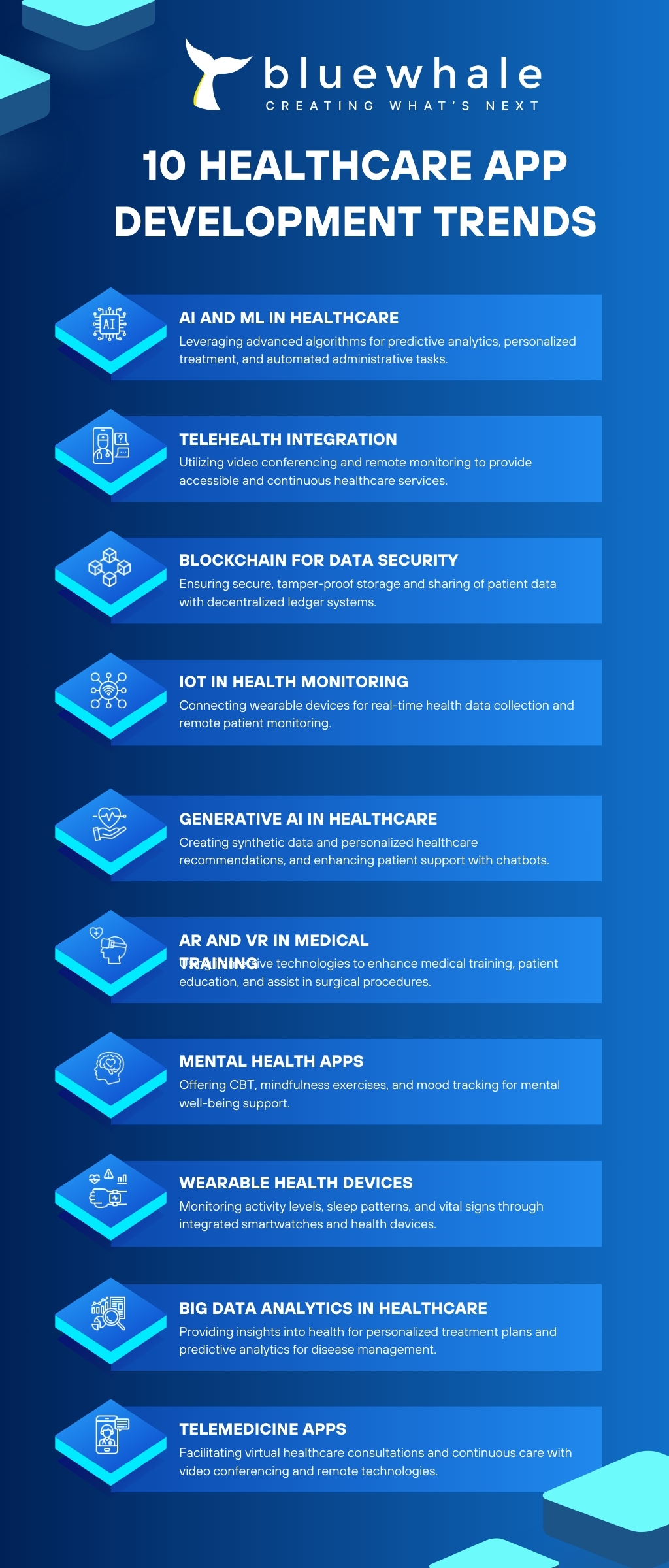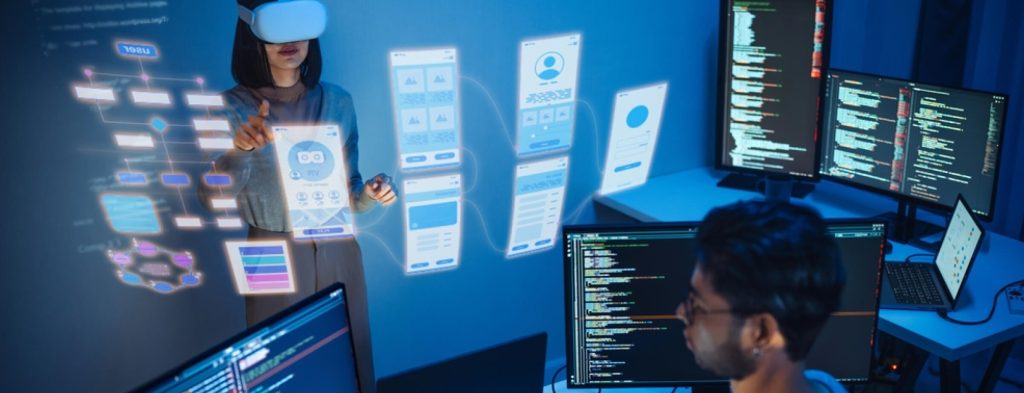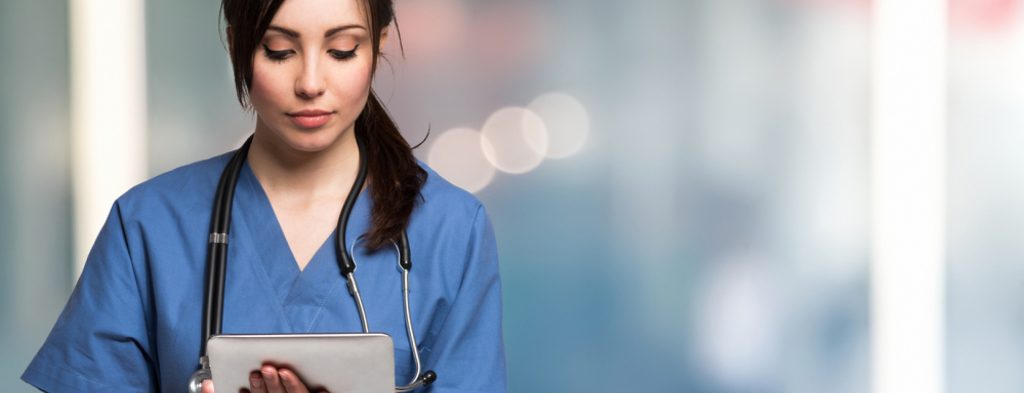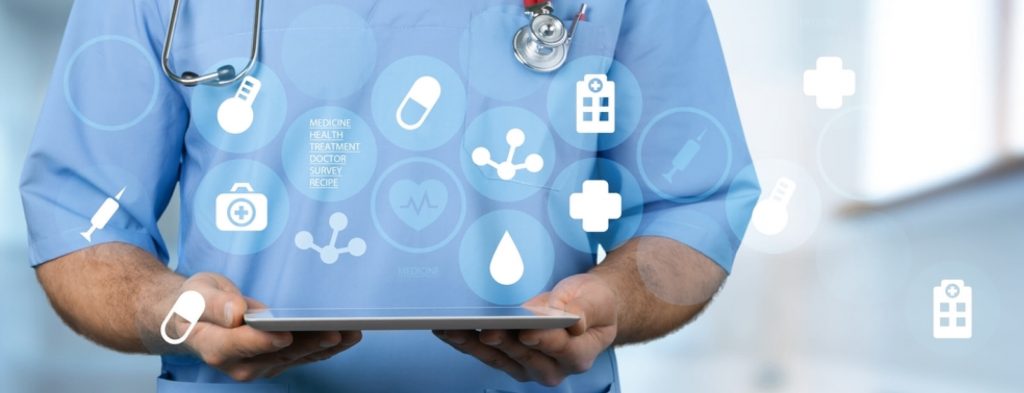Introduction
In the world of healthcare, mobile applications are revolutionizing patient care and access to medical services.
With over 350,000 mHealth applications available for Android and iOS platforms, the global mHealth app market is set to skyrocket, projected to reach an impressive $861.40 billion by 2030, growing at a robust CAGR of 40.2% from 2023 to 2030.
New computer technologies are being used in health apps to give patients better care. These technologies include:
- Big Data: Helps handle lots of health information
- AI & ML: Smart computer systems that can learn and make decisions
- IoT: Connects devices to share health data
- Blockchain: Keeps health records safe and private
These tools help doctors and nurses give better care to patients.
Healthcare Industry: Facts and Statistics
The healthcare sector is vast and globally influential, with significant economic implications:
- Global healthcare market projections:
- Estimated to reach $974.5 billion by 2027
- Telemedicine market growth:
- Projected to reach $286.22 billion by 2030
- Blockchain in healthcare:
- Global market anticipated to reach $14.25 billion by 2033
- Digital transformation in US healthcare:
- Investments in cloud technologies expected to reach $29.15 billion by 2026
- Mobile Health (mHealth) market:
- Wellness healthcare app sector estimated to reach $9.9 billion by 2030
Here are 10 healthcare app development trends that are revolutionizing the online healthcare market.

-
Artificial Intelligence (AI) and Machine Learning (ML)
Underlying Technologies
AI and ML utilize advanced algorithms and data processing tools for predictive analytics, personalized medicine, and automated workflows.
Potential Benefits and Applications
- Predictive Analytics: Forecast patient outcomes and disease progression.
- Personalized Medicine: Tailor treatment plans based on individual patient data.
- Automated Workflows: Streamline administrative tasks for healthcare providers.
Example
HingeHealth uses AI for personalized physical therapy programs, integrating predictive analytics for improved treatment outcomes.
-
Telehealth Integration
Underlying Technologies
Telehealth integrates video conferencing tools, remote monitoring devices, and secure communication platforms.
Potential Benefits and Applications
- Remote Consultations: Enhance accessibility to healthcare services.
- Continuous Monitoring: Track health metrics remotely.
- Cost Reduction: Lower healthcare costs by reducing in-person visits.
Example
Kry offers 24/7 video appointments with healthcare professionals, ensuring continuous access to medical consultations.
-
Blockchain Technology
Underlying Technologies
Blockchain ensures secure and tamper-proof data storage through decentralized ledger systems.
Potential Benefits and Applications
- Data Security: Safeguard patient data with immutable records.
- Interoperability: Facilitate secure data sharing across healthcare systems.
- Patient Control: Enhance privacy by giving patients control over their data.
Example
Medblock enables secure sharing of patient data across healthcare organizations using blockchain technology.
-
Internet of Things (IoT) Integration
Underlying Technologies
IoT connects devices like wearable health monitors to the internet, enabling real-time data collection and analysis.
Potential Benefits and Applications
- Smart Home Healthcare: Monitor health devices remotely.
- Wearable Health Devices: Track real-time health stats.
- Enhanced Patient Monitoring: Continuously monitor patient health metrics.
Example
Smart home applications and wearable devices provide real-time health data connected to healthcare apps.
-
Generative AI
Underlying Technologies
Generative AI creates synthetic data, develops chatbots, and provides personalized healthcare recommendations.
Potential Benefits and Applications
- Synthetic Data Creation: Generate data for training medical AI.
- Personalized Recommendations: Offer tailored healthcare advice.
- Enhanced Patient Journey: Develop chatbots for patient support.
Example
Headspace utilizes generative AI to offer personalized mental wellness recommendations.
-
Augmented Reality (AR) and Virtual Reality (VR)
Underlying Technologies
AR and VR enhance medical training, patient education, and surgical procedures through immersive experiences.
Potential Benefits and Applications
- Medical Training: Simulate medical scenarios for training.
- Patient Education: Visualize complex medical information.
- Surgical Assistance: Provide real-time data during procedures.
Example
The AED4EU app uses AR for quick diagnosis and locating nearby defibrillators.
-
Mental Health Apps
Underlying Technologies
Mental health apps use CBT, mindfulness exercises, and mood tracking to support mental well-being.
Potential Benefits and Applications
- Mental Health Support: Accessible mental health resources.
- Stress Management: Offer relaxation exercises.
- Mood Tracking: Monitor and manage mental health.
Example
Calm and Headspace provide mindfulness and relaxation exercises through their mental health apps.
-
Wearable Device Integration
Underlying Technologies
Wearable devices like smartwatches monitor activity levels, sleep patterns, and vital signs for comprehensive health tracking.
Potential Benefits and Applications
- Activity Tracking: Monitor physical activity for fitness improvement.
- Health Monitoring: Track vital signs in real-time.
- Personalized Health Plans: Develop customized health and fitness plans.
Example
Apple Health integrates with various wearable devices to analyze health data effectively.
-
Big Data and Analytics
Underlying Technologies
Big data analytics offer insights into human health, enabling personalized treatment and predictive analytics.
Potential Benefits and Applications
- Personalized Treatment: Tailor treatment plans based on data insights.
- Predictive Analytics: Forecast disease outbreaks and patient outcomes.
- Research and Development: Support drug discovery and clinical research.
Example
IBM Watson Health uses big data to provide insights into patient care and treatment options.
-
Telemedicine Apps
Underlying Technologies
Telemedicine apps facilitate virtual consultations through video conferencing and remote monitoring technologies.
Potential Benefits and Applications
- Improved Access to Care: Access healthcare services from anywhere.
- Cost Reduction: Lower healthcare costs by reducing in-person visits.
- Continuous Care: Provide ongoing support for chronic conditions.
Example
Teladoc offers a comprehensive telemedicine platform for virtual consultations and remote patient monitoring.
Future Trends
- Web 3.0 leading to decentralization of data, shifting power to citizens
- Metaverse creating new spaces for healthcare organizations to engage and transact
- Widespread adoption of cognitive technologies (machine learning, natural language processing, speech recognition, robotics)
- Maturation of AI, automating routine tasks and enabling innovation
- Use of digital twins for simulating and predicting healthcare outcomes
- Increased demand for seamless, personalized, and omnichannel healthcare experiences
- Shift towards consumer-centric healthcare ecosystems
- Convergence and consolidation of healthcare markets
- Rise of digital platform-based healthcare consumption
- Movement towards employee-centric healthcare organizations, focusing on wellbeing
- Micro-credentialing for flexible skill development in healthcare workforce
- Borderless delivery of local healthcare services through digital enablement
- Community activation and partnerships to address complex health challenges
- Trend towards localism supported by global healthcare platforms
- Emergence of integrity-based healthcare economy with focus on accountability and transparency
- Increased pressure on healthcare organizations to reduce climate impacts
- ESG performance becoming crucial for accessing new capital in healthcare sector
Develop a Health App in 2024
If you want to develop a health app, here are some important things to think about:
- Solve one specific problem: Don’t try to do everything. Focus on helping with one particular health issue.
- Keep information safe: Make sure your app protects people’s private health data.
- Make it easy to use: Create an app that anyone can understand and use, no matter their age or tech skills.
- Work with health experts: Team up with doctors and nurses to make sure your app is helpful and correct.
Need Help? Try Blue Whale Apps
We can help you make a great health app quickly. They work with hospitals and health companies to create useful and safe apps.
Wrapping up
In 2024, health apps will do amazing things. They’ll let you talk to doctors from home, use smart computers to spot health problems, and use special devices to track your health. These apps will be easy to use and keep your information safe. All of this will help people get better healthcare.
FAQ
1. What are the emerging trends in healthcare app development for 2024?
In 2024, healthcare app development is expected to be dominated by trends such as the integration of AI & ML, telehealth services, blockchain for data security, IoT for real-time monitoring, and the use of Big Data for predictive analytics. These trends aim to enhance personalized medicine, improve patient outcomes, and streamline healthcare operations.
2. How do healthcare apps enhance patient engagement?
Healthcare apps enhance patient engagement by providing patients with easy access to their medical records, appointment scheduling, telehealth consultations, and personalized health tips. These apps often feature reminders for medication and follow-up appointments, interactive health tracking, and direct communication with healthcare providers, fostering a more proactive approach to health management.
3. What role does IoT play in modern healthcare apps?
IoT plays a crucial role in modern healthcare apps by enabling continuous monitoring of patient health through connected devices such as wearable fitness trackers, smart home health devices, and remote patient monitoring systems. This real-time data collection helps healthcare providers make informed decisions, monitor chronic conditions, and promptly respond to any health anomalies.
4. Why is blockchain technology important for healthcare apps?
Blockchain technology is important for healthcare apps because it ensures that patient data is secure, transparent, and tamper-proof. By using a decentralized ledger, blockchain facilitates secure sharing of medical records across different healthcare providers while maintaining patient privacy and control over their own data.
5. How do mental health apps contribute to user well-being?
Mental health apps contribute to user well-being by offering accessible tools for managing stress, anxiety, and depression. These apps provide features such as guided meditation, cognitive behavioral therapy (CBT) exercises, mood tracking, and virtual consultations with mental health professionals. By making mental health resources more accessible, these apps help users maintain mental wellness and seek timely support.
6. What advancements are being made in telehealth services?
Advancements in telehealth services include the integration of high-definition video conferencing, remote diagnostics, AI-powered virtual assistants, and advanced wearable devices for remote monitoring. These innovations enable healthcare providers to deliver high-quality care to patients regardless of their location, improving access to medical services and reducing the need for in-person visits.
7. How are wearable devices transforming healthcare?
Wearable devices are transforming healthcare by providing continuous monitoring of vital signs, physical activity, and sleep patterns. These devices sync with healthcare apps to offer real-time health data, enabling personalized health recommendations, early detection of potential health issues, and better management of chronic conditions.
8. What benefits do big data and analytics bring to healthcare apps?
Big data and analytics bring numerous benefits to healthcare apps by enabling personalized treatment plans, predictive analytics, and improved patient outcomes. By analyzing large datasets, healthcare providers can identify trends, predict disease outbreaks, enhance clinical decision-making, and streamline operational efficiencies.
9. How do augmented reality (AR) and virtual reality (VR) enhance healthcare training?
AR and VR enhance healthcare training by providing immersive and interactive simulations for medical students and professionals. These technologies allow for realistic practice of surgical procedures, anatomy studies, and patient interaction scenarios, improving the skills and confidence of healthcare practitioners.
10. What is the impact of AI on diagnostic accuracy in healthcare?
AI significantly improves diagnostic accuracy in healthcare by analyzing medical images, interpreting complex datasets, and providing evidence-based recommendations. AI algorithms can detect patterns and anomalies that may be missed by human eyes, leading to earlier and more accurate diagnoses, ultimately improving patient outcomes.






